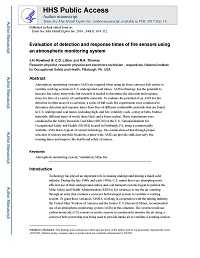Mining Publication: Evaluation of Detection and Response Times of Fire Sensors Using an Atmospheric Monitoring System
Original creation date: March 2016
Atmospheric monitoring systems (AMS) are required when using air from conveyor belt entries to ventilate working sections in U.S. underground coal mines. AMS technology has the potential to increase fire safety mine-wide, but research is needed to determine the detection and response times for fires of a variety of combustible materials. To evaluate the potential of an AMS for fire detection in other areas of a coal mine, a series of full-scale fire experiments were conducted to determine detection and response times from fires of different combustible materials that are found in U.S. underground coal mines, including high- and low-volatility coals, conveyor belts, brattice materials, different types of wood, diesel fuel, and a foam sealant. These experiments were conducted in the Safety Research Coal Mine (SRCM) of the U.S. National Institute for Occupational Safety and Health (NIOSH) located in Pittsburgh, PA, using a commercially available AMS that is typical of current technology. The results showed that through proper selection of sensors and their locations, a mine-wide AMS can provide sufficient early fire warning times and improve the health and safety of miners.
Authors: JH Rowland, CD Litton, RA Thomas
Peer Reviewed Journal Article - March 2016
NIOSHTIC2 Number: 8168
Trans Soc Min Metal Explor 2016 Mar; 340:104-112
See Also
- A Comparison of Mine Fire Sensors
- Development and Application of Reservoir Models and Artificial Neural Networks for Optimizing Ventilation Air Requirements in Development Mining of Coal Seams
- Dust Considerations When Using Belt Entry Air to Ventilate Work Areas
- Evaluation of the Relative Importance of Coalbed Reservoir Parameters for Prediction of Methane Inflow Rates During Mining of Longwall Development Entries
- Experimental and Modeling Investigation of the Effect of Ventilation on Smoke Rollback in a Mine Entry
- In-Mine Evaluation of Smart Mine Fire Sensor
- Modeling and Prediction of Ventilation Methane Emissions of U.S. Longwall Mines Using Supervised Artificial Neural Networks
- Real-time method to characterize a mine fire using atmospheric monitoring systems and MFIRE 3.0
- Strengthening Existing 20-psi Mine Ventilation Seals With Carbon Fiber-Reinforced Polymer Reinforcement
- Use of Vertical Boreholes for Assisting Ventilation of Longwall Gob Areas
- Content source: National Institute for Occupational Safety and Health, Mining Program


 ShareCompartir
ShareCompartir
